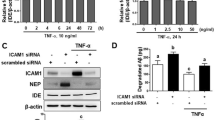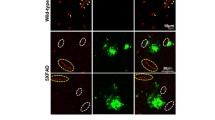Abstract
Alzheimer's disease (AD) is known to be associated with microcirculatory injury, capillary blockage, and disruption of the blood–brain barrier. Endothelial dysfunction has also been reported to be associated with AD, but the underlying mechanisms remain to be elucidated. Endothelial protein C receptor (EPCR) is an N-glycosylated type I membrane protein that enhances the activation of protein C. However, the effects of EPCR and protein C in AD are still unknown. In this study, we found that the expression of EPCR was reduced in the brains of β-amyloid precursor protein overexpressing Tg2576 transgenic mice at both the mRNA level and the protein level. However, levels of thrombomodulin (TM) did not undergo any changes. An in vitro study displayed that β-amyloid (Aβ) treatment led to suppression of EPCR along with reduction of protein C activation in mouse primary endothelial cells. Further study revealed that the induction of the c-Jun N-terminal kinase (JNK)/c-Jun pathway plays a causal role in the inhibitory effects of Aβ1–42 on the expression of EPCR. As a transcriptional factor, c-Jun was able to transinactivate the EPCR promoter. Finally, we found that c-Jun silencing or the use of a JNK inhibitor could attenuate the effects of Aβ1–42 in the activation of protein C.







Similar content being viewed by others
References
Anderson AJ, Cummings BJ, Cotman CW (1994) Increased immunoreactivity for Jun- and Fos-related proteins in Alzheimer's disease: association with pathology. Exp Neurol 125:286–295
Bernard GR, Vincent JL, Laterre PF, LaRosa SP, Dhainaut JF, Lopez-Rodriguez A, Steingrub JS, Garber GE, Helterbrand JD, Ely EW, Fisher CJ Jr, Recombinant human protein C Worldwide Evaluation in Severe Sepsis (PROWESS) study group (2001) Efficacy and safety of recombinant human activated protein C for severe sepsis. N Engl J Med 344:699–709
Braithwaite SP, Schmid RS, He DN, Sung ML, Cho S, Resnick L, Monaghan MM, Hirst WD, Essrich C, Reinhart PH, Lo DC (2010) Inhibition of c-Jun kinase provides neuroprotection in a model of Alzheimer's disease. Neurobiol Dis 39:311–317
Cheng T, Liu D, Griffin JH, Fernández JA, Castellino F, Rosen ED, Fukudome K, Zlokovic BV (2003) Activated protein C blocks p53-mediated apoptosis in ischemic human brain endothelium and is neuroprotective. Nat Med 9:338–342
Dahlbäck B, Villoutreix BO (2005) Regulation of blood coagulation by the protein C anticoagulant pathway: novel insights into structure-function relationships and molecular recognition. Arterioscler Thromb Vasc Biol 25:1311–1320
De Strooper B (2010) Proteases and proteolysis in Alzheimer disease: a multifactorial view on the disease process. Physiol Rev 90:465–494
Deane R, LaRue B, Sagare AP, Castellino FJ, Zhong Z, Zlokovic BV (2009) Endothelial protein C receptor-assisted transport of activated protein C across the mouse blood–brain barrier. J Cereb Blood Flow Metab 29:25–33
Esmon CT, Glass JD (2009) The APCs of neuroprotection. J Clin Invest 119:3205–3207
Gosselet F, Candela P, Cecchelli R, Fenart L (2011) Role of the blood–brain barrier in Alzheimer's disease. Med Sci (Paris) 27:987–992
Griffin JH, Zlokovic BV, Mosnier LO (2012) Protein C anticoagulant and cytoprotective pathways. Int J Hematol 95:333–345
Han MH, Hwang SI, Roy DB, Lundgren DH, Price JV, Ousman SS, Fernald GH, Gerlitz B, Robinson WH, Baranzini SE, Grinnell BW, Raine CS, Sobel RA, Han DK, Steinman L (2008) Proteomic analysis of active multiple sclerosis lesions reveals therapeutic targets. Nature 45(1):1076–1081
Isermann B, Vinnikov IA, Madhusudhan T, Herzog S, Kashif M, Blautzik J, Corat MA, Zeier M, Blessing E, Oh J, Gerlitz B, Berg DT, Grinnell BW, Chavakis T, Esmon CT, Weiler H, Bierhaus A, Nawroth PP (2007) Activated protein C protects against diabetic nephropathy by inhibiting endothelial and podocyte apoptosis. Nat Med 13:1349–1358
Lai CS, Yu MS, Yuen WH, So KF, Zee SY, Chang RC (2008) Antagonizing beta-amyloid peptide neurotoxicity of the anti-aging fungus Ganoderma lucidum. Brain Res 1190:215–224
Li W, Zheng X, Gu J, Hunter J, Ferrell GL, Lupu F, Esmon NL, Esmon CT (2005) Overexpressing endothelial cell protein C receptor alters the hemostatic balance and protects mice from endotoxin. J Thromb Haemost 3:1351–1359
Mosnier LO, Zlokovic BV, Griffin JH (2007) The cytoprotective protein C pathway. Blood 109:3161–3172
Niemann HH, Jäger V, Butler PJ, van den Heuvel J, Schmidt S, Ferraris D, Gherardi E, Heinz DW (2007) Structure of the human receptor tyrosine kinase met in complex with the Listeria invasion protein InlB. Cell 130:235–246
Perry G, Zhu X, Smith MA, Sorensen A, Avila J (2013) Preface. Alzheimer's disease: advances for a new century. J Alzheimers Dis 33(Suppl 1):S1
Popescu BO, Toescu EC, Popescu LM, Bajenaru O, Muresanu DF, Schultzberg M, Bogdanovic N (2009) Blood–brain barrier alterations in ageing and dementia. J Neurol Sci 283:99–106
Pulverer BJ, Kyriakis JM, Avruch J, Nikolakaki E, Woodgett JR (1991) Phosphorylation of c-Jun mediated by MAP kinases. Nature 353:670–674
Sheng B, Gong K, Niu Y et al (2009) Inhibition of gamma-secretase activity reduces Abeta production, reduces oxidative stress, increases mitochondrial activity and leads to reduced vulnerability to apoptosis: implications for the treatment of Alzheimer's disease. Free Radic Biol Med 46(10):1362–1375
Stearns-Kurosawa DJ, Kurosawa S, Mollica JS, Ferrell GL, Esmon CT (1996) The endothelial cell protein C receptor augments protein C activation by the thrombin-thrombomodulin complex. Proc Natl Acad Sci U S A 93:10212–10216
Wang ZY, Sato H, Kusam S, Sehra S, Toney LM, Dent AL (2005) Regulation of IL-10 gene expression in Th2 cells by Jun proteins. J Immunol 174:2098–2105
Weller RO, Subash M, Preston SD et al (2008) Perivascular drainage of amyloid-beta peptides from the brain and its failure in cerebral amyloid angiopathy and Alzheimer's disease. Brain Pathol 18:253–266
Wu Z, Hofman FM, Zlokovic BV (2003) A simple method for isolation and characterization of mouse brain microvascular endothelial cells. J Neurosci Methods 130:53–63
Xie W, Zhai Z, Yang Y, Kuang T, Wang C (2012) Free fatty acids inhibit TM-EPCR expression through JNK pathway: an implication for the development of the prothrombotic state in metabolic syndrome. J Thromb Thrombolysis 34:468–474
Yavuz BB, Dede DS, Yavuz B, Cankurtaran M, Halil M, Ulger Z, Cankurtaran ES, Aytemir K, Kabakci G, Haznedaroglu IC, Ariogul S (2010) Potential biomarkers for vascular damage in Alzheimer's disease: thrombomodulin and von Willebrand factor. J Nutr Health Aging 14:439–441
Yu MS, Leung SK, Lai SW, Che CM, Zee SY, So KF, Yuen WH, Chang RC (2005) Neuroprotective effects of anti-aging oriental medicine Lycium barbarum against beta-amyloid peptide neurotoxicity. Exp Gerontol 40:716–727
Zhong Z, Ilieva H, Hallagan L, Bell R, Singh I, Paquette N, Thiyagarajan M, Deane R, Fernandez JA, Lane S, Zlokovic AB, Liu T, Griffin JH, Chow N, Castellino FJ, Stojanovic K, Cleveland DW, Zlokovic BV (2009) Activated protein C therapy slows ALS-like disease in mice by transcriptionally inhibiting SOD1 in motor neurons and microglia cells. J Clin Invest 119:3437–3449
Zhu X, Raina AK, Rottkamp CA, Aliev G, Perry G, Boux H, Smith MA (2001) Activation and redistribution of c-Jun N-terminal kinase/stress activated protein kinase in degenerating neurons in Alzheimer's disease. J Neurochem 76:435–441
Zlokovic BV (2005) Neurovascular mechanisms of Alzheimer's neurodegeneration. Trends Neurosci 28:202–208
Author information
Authors and Affiliations
Corresponding author
Rights and permissions
About this article
Cite this article
Zhang, X., Huang, L., Lu, G. et al. Amyloid β Suppresses Protein C Activation Through Inhibition of the Endothelial Protein C Receptor (EPCR). J Mol Neurosci 52, 117–123 (2014). https://doi.org/10.1007/s12031-013-0123-4
Received:
Accepted:
Published:
Issue Date:
DOI: https://doi.org/10.1007/s12031-013-0123-4




